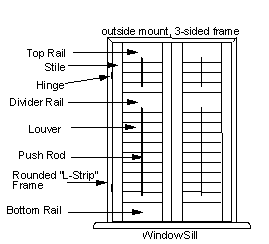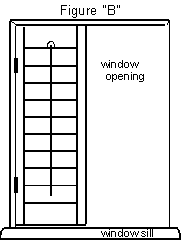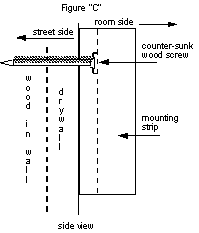Installation Instructions for Inside Z-Framed Mount
Using Z-strip to create a 3- or 4-sided frame mounted inside the window opening. (See figure below.)

This set of installation instructions is general in nature and should not be expected to answer all questions that may arise during an inside mount installation of Plantation Shutters. This type of mount is detailed, and you should read and follow these instructions carefully, guided by good common sense in identifying steps in your project that do not match these general instructions.
Tools needed:
- Phillips screwdriver (power screwdriver recommended)
General parts list:
- Shutter panels in correct sizes and numbers to fill the opening
- Z-Strips pre-mitered and pre-hinged for use as mounting strips
- Drywall screws for mounting strips (approx. 2-1/4" long)
- Non-mortise Hinges (bright brass or white) mounted, pins separate
- Inner-Panel Hinges (bright brass or white) mounted, pins separate
- Magnetic Catches
- Touch-up paint (when appropriate)
Unpack the cartons and carefully check for shipping damage and to see that you have all the items needed for your installation. Based on the size of the window opening involved, you should receive 1 or more individual shutter panels, 2 side mount strips, 1 top mount strip, 1 bottom mount strip if 4-sided frame, appropriate hinges already mounted, magnets, and (if the product is painted) a small bottle of touch-up paint. We do NOT include mounting screws because specific requirements vary from window to window. If anything is missing, re-check the packaging. If it is still missing, or if the shipment sustained damage in transit, contact the retail store where you purchased the shutters.
Steps:
1. These shutters are "custom" built, meaning that just as identical window openings vary slightly in width and height, the custom shutters built for those windows also vary to the same degree. Sort through the shutter panels in your order so that you know which panels combine to fit in each window opening. Each shutter panel, on the end, will be marked with your acknowledgement number, and with the number of the item on the acknowledgement (item #1 = window opening #1) to help you pair the panels up.
2. Within each window grouping all shutter panels will be the same height. Arrange the panels so that the rabbeted edges (see figure below) overlap each other properly. When all panels, mounting strips and hinges are placed together properly in this type of "framed" mount, the total width and height of the set should be the same as the width and height measurements given in your order.

With a 3-sided frame, the mounting strip sits on (or just above) the sill and the shutter panels start approximately 1/8 inch above the sill so they can swing freely, as in this drawing...
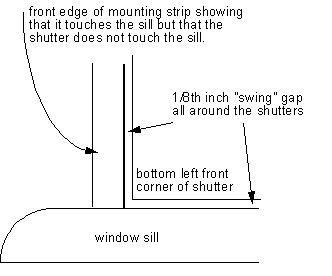
With a 4-sided frame, a bottom mounting strip of Z-strip is attached to the window sill and the shutter swings just above it. The effect is as if the shutter panels were completely surrounded by a "picture frame" made of Z-strip. In this case all the ends of all the mounting strips will be miter cut (45 degrees).
3. Install shutter panels with the "notch" for the pushrod at the top. When installed, the pushrod faces the room. (See figure below, left.)
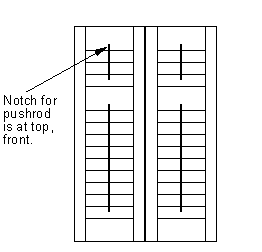
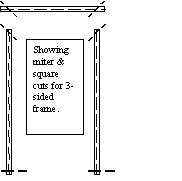
4. Each piece of mounting strip is precisely cut. If your original measurements on the order were accurate, these strips should not require adjustment or modification.
5. On a flat surface, assemble the 3- or 4-sided frame for your shutters using the included screws in the pre-drilled, counter-sunk screw holes that are perpendicular to each miter cut. Be very careful not to put undue strain on the corners of the frame as you handle it. Excessive force applied to the screws will split the wood. When the frame is assembled, place the shutter panels in position and replace all included hinge pins.

6. Attach the framing pieces to your window jamb with the provided 2-1/4" drywall screws, if you have either wooden or drywall jambs. Jambs of other types of material (brick, cement, metal, etc.) will require other types of screws or fasteners.
Please Note: Screws must be firmly set, and must anchor in wood or other structural material. DRYWALL (SHEETROCK) AND PANELING WILL NOT SUPPLY ADEQUATE STRENGTH IN MOUNTING, AND PRESENT A DANGER OF INJURY AND/OR DAMAGE. Your mounting strip must be attached to wood, through drywall into wood, or to other secure material.
7. Place the frame (usually done without the shutters in place... remove hinge pins) in the window. The mounting strip should be attached to the jamb with screws as shown in the drawing at the top of the first page. We recommend that you "counter-sink" the screws so when installation is complete the heads of the screws will be out of sight below the surface of the strip.
8. In this type of mount, it is sometimes necessary to "shim" between a framing piece and the jamb so the frame will be square and the shutter panels will fit properly within it. If spacer shims are needed, back the mounting screws out, insert the shims, and re-tighten the screws. Do not use excessive force in tightening the mounting screws because this could split the wood. Once firmly attached, replace the hinge pins you removed in the previous step. Carefully swing the shutter open to check for alignment problems in relation to the sill.
9. The magnets will be mounted at the top immediately behind the shutter panels on the edge of the top mounting strip that faces down. With the left shutter panel open on it's hinges, position a magnetic catch immediately behind the "stile" of the right panel. Using the 2 matching screws provided, attach the magnet to the trim. Magnetically stick the strike plate to the magnet with the 2 tiny "points" facing the room, then gently press the shutter panel against the strike plate to make marks in the wood of the shutter "stile". Using those marks as your placement guide, attach the strike plate to the back of the "stile" with the smallest screw provided (see figure below, left). Using the same procedure, attach any other magnetic catches that are appropriate to your installation. If you prefer, the magnets can be mounted to the sill, or to the bottom strip of a 4-sided frame.

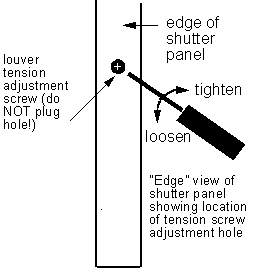
10. Use the touch-up paint (included if the shutters were painted at the factory) on any areas which were marred during the project.
11. All shutter panels come with "tension" screws deeply counter-sunk in each vertical edge. By simply turning the screw a little clockwise or counter-clockwise with your Phillips head screw driver, you can gently tighten or loosen the louver/pushrod tension in each individual panel to suit your preferences. When adjusting the tension, always spread the amount of adjustment evenly between all screws in BOTH edges of the individual panel (see figure above, right).
Installation Instructions for Outside L-Strip, 3-Sided Frame Mount
Using rounded L-strip to create a 3-sided frame mounted on trim or on wall surface. (See figure below.)
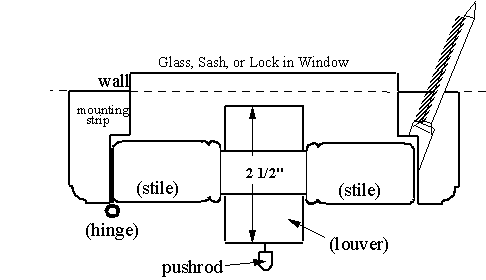
This set of installation instructions is general in nature and should not be expected to answer all questions that may arise during an outside mount installation of Plantation Shutters. This type of mount is detailed, and you should read and follow these instructions carefully, guided by good common sense in identifying steps in your project that do not match these general instructions.
Tools needed:
- Phillips screwdriver (power screwdriver recommended)
General parts list:
- Shutter panels in correct sizes and numbers to fill the opening
- Framing Strips pre-cut and pre-hinged to shutter panels
- Drywall screws for mounting strips (approx. 2-1/4" long)
- Non-mortise Hinges (bright brass or white) mounted, pins separate
- Inner-Panel Hinges (bright brass or white) mounted, pins separate
- Magnetic Catches
- Touch-up paint (when appropriate)
Before beginning, unpack the cartons and carefully check for shipping damage and to see that you have all the items needed for your installation. Based on the size of the window opening involved, you should receive 1 or more individual shutter panels, 2 side mount strips, 1 top trim strip, mounting screws, and magnets, and (if the product is painted) a small bottle of touch-up paint. If anything is missing, re-check the packaging. If it is still missing, or if the shipment sustained damage in transit, contact your retailer.
Steps:
1. These shutters are "custom" built, meaning that just as identical window openings vary slightly in width and height, the custom shutters built for those windows also vary to the same degree. Sort through the shutter panels in your order so that you know which panels combine to fit each window opening. Each shutter panel, on the end, will be marked with your acknowledgement number, and with the number of the item on the acknowledgement (item #1 = window opening #1) to help you pair the panels up.
2. Within each window grouping shutter panels will be exactly the same height. Arrange the panels so that the rabbeted edges (see figure below) overlap each other properly. When all panels and mounting strips are placed together properly in this type of "outside" mount, the total width of the set should be the same as was specified in your order. The finished height (full length or café-style) should be what you specified in your order. Note that café style shutters have no top trim piece. The hinges are included, and are attached at the factory. The hinge pins are removed at the factory, and will be replaced by you during installation.

With a 3-sided frame, the mounting strip sits on (or just above) the sill and the shutter panels start approximately 1/8 inch above the sill so they can swing freely, as in this drawing...
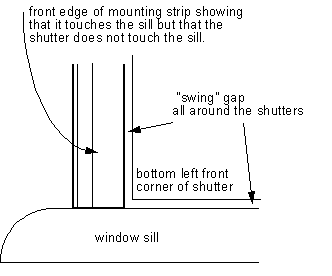
3. Install shutter panels with the "notch" for the pushrod at the top. When installed, the pushrod faces the room. (See figure below, left.)

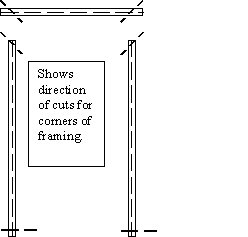
4. Each piece of mounting strip is precisely cut. (See figure above, right.) The 2 side pieces are "square" cut at the bottom, and "miter" cut (45 degrees) at the top. The top trim piece is miter cut on both ends. (Note: café style, covering the lower part of the window only, has no top trim piece, and the side pieces are square cut on all ends.)
5. The hinges are installed at the factory, and you will need to simply put the hinge pins back in the hinge after lining up the 2 parts of the hinge.
6. If your window opening contains more than 2 shutter panels, the "inner-panel" hinges were also installed at the factory. In like manner, line up the 2 parts of the hinge that are still attached to the shutter and the strip and place the pins in the hinges.
Please Note: Screws must be firmly set, and must anchor in wood or other structural material. DRYWALL (SHEETROCK) AND PANELING WILL NOT SUPPLY ADEQUATE STRENGTH IN MOUNTING, AND PRESENT A DANGER OF INJURY AND/OR DAMAGE. Your mounting strip must be attached to wood, through drywall into wood, or to other secure material.
7. Stand the left mounting strip on the sill and position it left-to-right so it is straight up and down and the outer edge is exactly where you want it. The mounting strip should be attached with screws as shown in the drawing at the top of the first page. The factory will have pre-drilled the countersink holes at an appropriate angle.
8. Hold the prepared strip in place and attach it to the wall with the screws. Excessive force will split the wood. Once firmly attached, replace the hinge pins. Carefully swing the shutter open to check for alignment problems in relation to the sill. It may be necessary (when window opening is out-of-square or off level) to adjust the strips up or down, in or out to achieve even clearance at the bottom and shutters that are in a flat plane.
9. Repeat the previous 2 steps for the other half of the window opening, making sure that the top framing piece will fit properly between the two side mounting strips before tightening the screws.
10. The remaining piece of mounting strip is the ornamental top piece. Place the top piece in position and attach it to the side pieces using the provided screws in the pre-drilled holes. Use care that on each end it forms a good joint with the side strip.
11. The magnets will be mounted at the top immediately behind the shutter panels on the edge of the top trim piece that faces down. (With café style, mount magnets on sill.) With the left shutter panel open on it's hinges, position a magnetic catch immediately behind the "stile" of the right panel. Using the 2 matching screws provided, attach the magnet to the top trim strip. Magnetically stick the strike plate to the magnet with the 2 tiny "points" facing the room, then gently press the shutter panel against the strike plate to make marks in the wood of the shutter "stile". Using those marks as your placement guide, attach the strike plate to the back of the "stile" with the smallest screw provided (see figure below, left). Using the same procedure, attach any other magnetic catches that are appropriate to your installation.
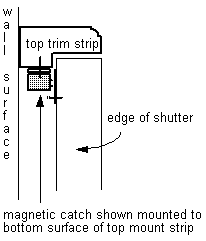
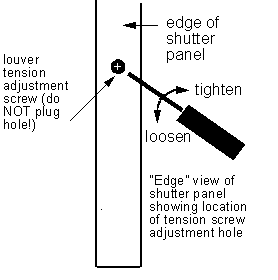
12. Use the touch-up paint (included if the shutters were painted at the factory) on any areas which were marred during the project.
13. All shutter panels come with "tension" screws deeply counter-sunk in each vertical edge. By simply turning the screw a little clockwise or counter-clockwise with your Phillips head screw driver, you can gently tighten or loosen the louver/pushrod tension in each individual panel to suit your preferences. When adjusting the tension, always spread the amount of adjustment evenly between all screws in BOTH edges of the individual panel (see figure above, right)
